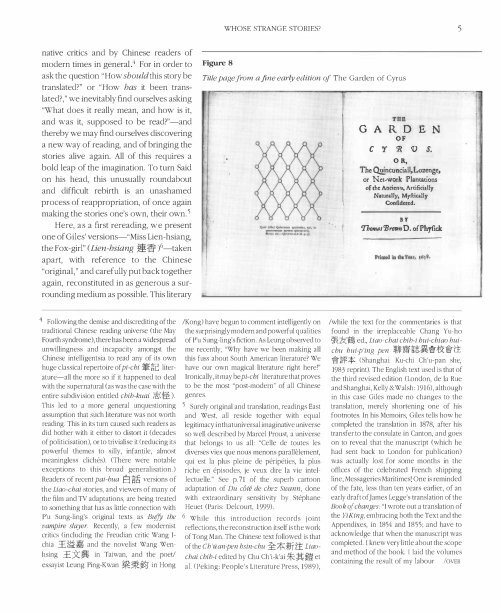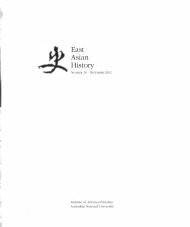Whose Strange Stories? P'u Sung-ling (1640 - East Asian History
Whose Strange Stories? P'u Sung-ling (1640 - East Asian History
Whose Strange Stories? P'u Sung-ling (1640 - East Asian History
You also want an ePaper? Increase the reach of your titles
YUMPU automatically turns print PDFs into web optimized ePapers that Google loves.
WHOSE STRANGE STORIES?<br />
native critics and by Chinese readers of<br />
modern times in general 4 For in order to Figure 8<br />
ask the question "How should this story be Title page from a fine early edition of The Garden of Cyrus<br />
translated?" or "How has it been translated?,"<br />
we inevitably find ourselves asking<br />
"What does it really mean, and how is it,<br />
and was it, supposed to be read?"-and<br />
thereby we may find ourselves discovering<br />
a new way of reading, and of bringing the<br />
stories alive again. All of this requires a<br />
bold leap of the imagination. To turn Said<br />
on his head, this unusually roundabout<br />
and difficult rebirth is an unashamed<br />
process of reappropriation, of once again<br />
making the stories one's own, their own.5<br />
Here, as a first rereading, we present<br />
one of Giles' versions-"Miss Lien-hsiang,<br />
the Fox-girl" (Lien-hsiang W )6-taken<br />
apart, with reference to the Chinese<br />
"original," and carefully put back together<br />
again, reconstituted in as generous a surrounding<br />
medium as possible. This literary<br />
4 Following the demise and discrediting of the<br />
traditional Chinese reading universe (the May<br />
Fourth syndrome), there has been a widespread<br />
unwil<strong>ling</strong>ness and incapacity amongst the<br />
Chinese intelligentsia to read any of its own<br />
huge classical repertoire of pi-chi liter<br />
ature-all the more so if it happened to deal<br />
with the supernatural (as was the case with the<br />
entire subdivision entitled chih-kuai ;E;'i,£).<br />
This led to a more general unquestioning<br />
assumption that such literature was not worth<br />
reading. This in its turn caused such readers as<br />
did bother with it either to distort it (decades<br />
of politicisation), or to trivialise it (reducing its<br />
powerful themes to silly, infantile, almost<br />
meaningless cliches). (There were notable<br />
exceptions to this broad generalisation.)<br />
Readers of recent pai-hua B I!i versions of<br />
the Liaa-chai stories, and viewers of many of<br />
the film and TV adaptations, are being treated<br />
to something that has as little connection with<br />
<strong>P'u</strong> <strong>Sung</strong>-<strong>ling</strong>'s original texts as Buffy the<br />
vampire slayer. Recently, a few modernist<br />
critics (including the Freudian critic Wang 1chia<br />
.:E and the novelist Wang Wen<br />
hsing .:E)( in Taiwan, and the poet/<br />
essayist Leung Ping-Kwan *tJ in Hong<br />
/Kong) have begun to comment intelligently on<br />
the surprisingly modern and powerful qualities<br />
of <strong>P'u</strong> <strong>Sung</strong>-<strong>ling</strong>'s fiction. As Leung observed to<br />
me recently, "Why have we been making all<br />
this fuss about South American literature? We<br />
have our own magical literature right here!"<br />
Ironically, it may bepi-chi literature that proves<br />
to be the most "post-modern" of all Chinese<br />
genres.<br />
5 Surely original and translation, readings <strong>East</strong><br />
and West, all reside together with equal<br />
legitimacy in that universal imaginative universe<br />
so well described by Marcel Proust, a universe<br />
that belongs to us all: "Celle de toutes les<br />
diverses vies que nous me nons parallelement,<br />
qui est la plus pleine de peripeties, la plus<br />
riche en episodes, je veux dire la vie intellectuelle."<br />
See p.71 of the superb cartoon<br />
adaptation of Du cote de chez Swann, done<br />
with extraordinary sensitivity by Stephane<br />
Heuet (Paris: Delcourt, 1999),<br />
6 While this introduction records joint<br />
reflections, the reconstruction itself is the work<br />
of Tong Man. The Chinese text followed is that<br />
of the Ch 'iian-pen hsin-chu ::

















